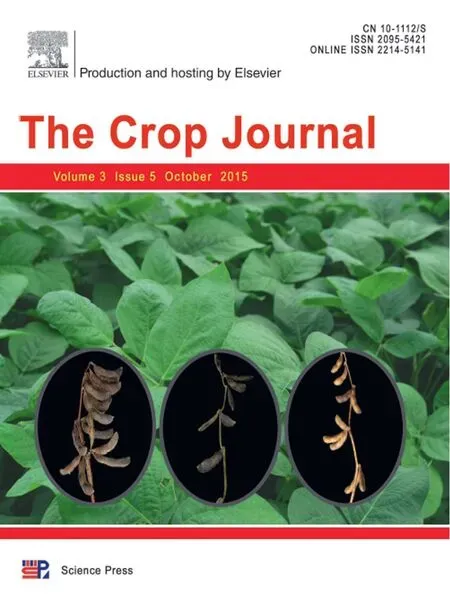Field evaluation of durum wheat landraces for prevailing abiotic and biotic stresses in highland rainfed regions of Iran
2015-08-15RezMohmmiBehzSeghzehHsnAhmiNowzrBhrmiAhmeAmri
Rez Mohmmi*,Behz Seghzeh,Hsn Ahmi,Nowzr BhrmiAhme Amri
aDryland Agricultural Research Institute(DARI),P.O.Box 67145-1164,Kermanshah,AREEO,IranbDryland Agricultural Research Institute(DARI),Maragheh,AREEO,IrancCenter of Agricultural Research and Natural Resources,Kurdistan,AREEO,IrandInternational Center for Agricultural Research in the Dry Areas(ICARDA),Rabat,Morocco
Field evaluation of durum wheat landraces for prevailing abiotic and biotic stresses in highland rainfed regions of Iran
Reza Mohammadia,*,Behzad Sadeghzadehb,Hasan Ahmadic,Nowzar Bahramia,Ahmed Amrid
aDryland Agricultural Research Institute(DARI),P.O.Box 67145-1164,Kermanshah,AREEO,IranbDryland Agricultural Research Institute(DARI),Maragheh,AREEO,Iran
cCenter of Agricultural Research and Natural Resources,Kurdistan,AREEO,Iran
dInternational Center for Agricultural Research in the Dry Areas(ICARDA),Rabat,Morocco
A R T I C L E I N F O
Article history:
Receivedinrevisedform24March2015
Accepted 27 March 2015
Available online 15 May 2015
Durum wheat
Landraces
Biotic and abiotic stresses Phenotypic diversity
A B S T R A C T
Biotic and abiotic stresses are major limiting factors for high crop productivity worldwide.A landrace collection consisting of 380 durum wheat(Triticum turgidum L.var.durum)entries originatinginseveralcountriesalongwithfourcheckvarietieswereevaluatedforbioticstresses: yellowrust(PucciniastriiformisWestendorff.sp.tritici)andwheatstemsawfly(WSS)Cephuscinctus Norton(Hymenoptera:Cephidae),and abiotic stresses:cold and drought.The main objectives were to(i)quantify phenotypic diversity and identify variation in thedurumwheatlandraces for the different stresses and(ii)characterize the agronomic profiles of landraces in reaction to the stresses.Significant changes in reactions of landraces to stresses were observed. Landraces resistant to each stress were identified and agronomically characterized. Percentage reduction due to the stresses varied from 11.4%(yellow rust)to 21.6%(cold stress)for 1000-kernel weight(TKW)and from 19.9(yellow rust)to 91.9%(cold stress)for grain yield.Landraces from Asia and Europe showed enhanced genetic potential for both grain yield and cold tolerance under highland rainfed conditions of Iran.The findings showed that TKW and yield productivity could be used to assess the response of durum wheat landraces to different stresses.In conclusion,landraces showed high levels of resistance to both biotic and abiotic stresses,and selected landraces can serve in durum wheat breeding for adaptation to cold and drought-prone environments.
©2015 Crop Science Society of China and Institute of Crop Science,CAAS.Production and hosting by Elsevier B.V.This is an open access article under the CC BY-NC-ND license (http://creativecommons.org/licenses/by-nc-nd/4.0/).
1.Introduction
Wheat landraces are variable,genetically dynamic,and in equilibrium with biotic and abiotic stresses in the environments where they evolve.The development of new varieties using wheat landraces is a practical strategy for improving yield and yield stability,especially under stresses and future climate change conditions.Wheat landraces adapt to changing climateconditions andto harshenvironments,owing totheirpopulation genetic structure,buffering capacity,and combinations of agro-physiological traits conferring adaptability to stress environments[1].Wheat landraces are still cultivated in western Asia and North Africa,with some also found in Ethiopia,China,the Indian subcontinent,and small areas of Latin America.The proportion of wheat area planted to landraces also varies by wheat type and environment.For example,in developing countries,23%of the area planted to durum wheat and 12%of the area planted to winter bread wheat are sown to landraces,while only 3%of the spring bread wheat area is still planted to landraces[2].
There is growing interest in use of available genetic resources in the development of new durum wheat cultivars that tolerate major biotic and abiotic stresses and for the improvement of crop productivity and quality[3].This development will require thorough understanding of the available genetic variation in landraces,primitive wheats,and wild relative species.The rate of progress,however,will depend on the presence of genetic variation for desired traits and the availability of reliable methods for the identification,selection,and transfer of superior genes[3].
Drought stress is a major problem for agricultural production in many parts of the world.Because drought is the single largest abiotic stress factor leading to reduced crop yields,varieties that yield well even in environmentally stressful conditions are essential[4,5].Climate change is projected to have a large impact on temperature and precipitation profiles,increasing the incidence and severity of drought.The extension of durum wheat into areas with cold winters is limited by the cold susceptibility of existing landraces.Low temperature often affects plant growth and crop productivity and causes severe crop losses[6].Plants differ in their tolerance to chilling (0—15°C)and freezing(<0°C)temperatures[7].Besides abiotic stresses,wheatyellowrust,causedbyPucciniastriiformis Westendorf f.sp.tritici,the most common and widely distributed wheat rust in the world[8],and wheat stem sawfly[Cephus pygmaeus(L.)Hym.Cephidae],which is a major problem in the Mediterranean basin[9],limit wheat production.
Deploymentof genetic resistancetothesestressesislikelyto be the most economical and environmentally friendly control measure[9—12].Characterization of the population structure of wheat landraces is critical for identifying and correctly interpreting the association between functional and molecular diversity.Such information is essential for using landraces as trait donors in wheat breeding,defining the areas of their adaptation,identifyingpriorityareasforpromotingtheiron-farm conservation,and evaluating the genetic consequences of the interaction between climate change,growing environment,and farmers'practice.Accordingly,the main objectives of this study were to(i)quantify phenotypic diversity and identify variation in the durum wheat landraces for major biotic and abiotic stresses,(ii)characterize the agronomic profiles of different subsets of landraces(as resistant,moderately resistant,moderately susceptible,or susceptible)to different stresses and(iii)investigate the potential of landraces to combine tolerance to biotic and abiotic stresses with good agronomic performance.This information could greatly assist in the conservation of durum landraces and their efficient deployment in durum breeding programs.
2.Materials and methods
2.1.Plant materials and experimental layout
A subset of 380 durum wheat landraces collected from a wide range of agricultural zones worldwide were selected from the landraces conserved in the Iranian gene bank.The subset collection consisted of landraces from 16 countries:Iran(307;collected from a wide geographic area across the country),Japan(16),Afghanistan(8),Australia(9),Bulgaria(5),Portugal (5),Turkey(5),United States(5),former Yugoslavia(2),Italy(3),Iraq(2),China(2),Argentina(2),France(1),Greece(1),and Austria(1)and six landraces of unknown origin.This subset was evaluated at three rainfed research stations of the Dryland Agricultural Research Institute(DARI),Iran,during the 2009—2011 cropping seasons.The three research stations represent cold rainfed regions(Maragheh station,37°22'N,46°15'E and 1400 m.a.s.l.and Qamloo station,35°23'N,47°14'E and1850 m.a.s.l.)andmoderatelycoldrainfedregions (Sararood station,34°19'N,47°17'E and 1351 m.a.s.l.)for durum wheat production in Iran.
Each landrace was sown in two rows 2.5 m long with 20.0 cm row spacing in an unreplicated trial with four checks repeated every 20 entries at each research station.The checks consisted of two durum genotypes including Dena(a newly released durum variety originating from CIMMYT germplasm having high yielding performance,high pasta quality,and adaptation to favorable conditions)and Zardak(an old durum variety with high grain weight and average yield productivity and adaptation to unfavorable conditions)and two bread wheats including Saison(a winter variety from France having high yield and tolerance to terminal drought)and Verinak (a spring cultivar from CIMMYT with earliness and tolerance to terminal drought and heat stresses).Standard crop cultural practices were used at all test locations.Weeds were controlled manually as required.Fertilizer rate was 50 kg N ha—1and 50 kg P2O5ha—1applied at planting.
The landraces were evaluated for several drought-adaptive traits:days to heading(DTH),days to maturity(DTM),plant height(PLH),thousand-kernel weight(TKW),and grain yield (YLD)under rainfed conditions in each location and scored for cold stress,yellow rust and wheat stem sawfly(Table 1).
2.2.Statistical analysis
Data were statistically analyzed to identify landraces that were genetically different or similar based on the environmental stresses and agronomic traits measured.The grain yield data and other measured traits(DTH,DTM,PLH,and TKW)were analyzed separately with GenStat[14]for spatial analysis of un-replicatedtrialsinwhichtheresponsesoftherepeatedchecks providethebasisformodelingthespatialvariationinthefieldfor adjusting genotype performance[15].For each trait,the best linear unbiased predictions(BLUPs)from the best-fitting model were used as adjusted data.
To display the relationships among the landrace groups and measured traits,a graphical biplot,the genotype-by-trait (GT)biplot described by Yan and Rajcan[16]was constructed,for each of the environments differing in stress conditions,byplottingthefirstprincipalcomponent(PC1)scoresofthelandrace groups and the traits against their respective scores for the second principal component(PC2)resulting from singular-value decomposition(SVD)oftrait-standardizeddataineach environment.In the GT biplot,vectors are drawn from the biplot origin to the trait markers to facilitate visualization of the relationships among the traits.The correlation coefficient between any two traits is approximated by the cosine of the angle between their vectors.Acute angles indicate positive correlations,obtuseanglesnegativecorrelations,andrightangles no correlation.A short vector may indicate that the trait is not related to other traits.All biplots were generated with the GGEbiplot software[17].
To characterize the agronomic performance of each landrace group,the“which-for-what”pattern of the GT biplot was used.This operation is performed by connecting the furthest groupsfromtheoriginwithstraightlinestoformapolygon.The polygon view of a biplot is the best way to visualize the interaction patterns between landrace groups and traits and to interpret effectively the results of the biplot[16].

Fig.1-Monthlydistributionofrainfallandminimumtemperaturesatthreeresearchstationsduringthe2009-2011croppingseasons.

Table2-Listofoutstandingentriesamong380durumwheat landraces with resistance/tolerance to biotic(yellow rust and wheat stem sawfly)and abiotic(cold stress)stresses along with the check cultivars.
3.Results
3.1.Climatic condition of test locations
No large differences in total amount of rainfall were observed among the three locations in 2010—2011,although the locations differed in their monthly rainfall distribution(Fig.1).Total rainfall amounts were 342.5,351.4,and 346.6 mm at Sararood,Maragheh,and Qamloo,respectively.Rainfall at the cold stations (Maragheh and Qamloo)was around the long-term average,but at the moderately cold station(Sararood)was significantly less than the long-term average(445 mm).The locations differed in temperature.The absolute minimum temperature during the cropping season was—30°C at Qamloo,—20°C at Maragheh,and—9°C at Sararood.Average minimum temperatures at Qamloo,Maragheh and Sararood were—10.6,—6.9,and—2.2°C,respectively.ThenumberoffreezingdaysatQamloowas132,at Maragheh 130,and at Sararood 75.In conclusion,rainfall distribution and temperature were contrasting at the locations,showing that the landraces experienced both cold and drought stresses during the season.In Sararood,the 2009—2010 cropping season was optimum for crop growth;the precipitation was453.9 mm,slightly higher than the long-termaverage(445 mm)for Sararood research station,and the crop growth experienced minimum and maximum temperatures of—8.6 and 38.3°C,respectively.In contrast,the next cropping season,2010—2011 experienced severe drought,with a marked decrease in rainfall by 111.4 mm relative to the optimum year(2009—2010).However,no large changes in temperature were observed over the two cropping seasons at this location(Fig.1).
3.2.Data description
The mean grain yields for each location reflect the relative severity of the stresses experienced.Mean yields were 3644,2610,1627,and 2534 kg ha—1at Sararood(2009—2010),Sararood (2010—2011),Maragheh(2010—2011),and Qamloo(2010—2011),respectively(data not shown),giving a mean yield reduction from the moderately cold to cold locations.In contrast,a mean reduction in TKW from 35 to 25 g among the landraces was observed from cold to moderately cold locations,indicating a negative correlation between yield and TKW among the landraces.A mean reduction in plant stature was observed for the landraces from moderately cold(102—115 cm)to cold (62—88 cm)stations.For days to heading and maturity,the landraces tended to be earlier in the moderately cold than the cold locations.
The percentage reduction due to yellow rust varied from 7.7%to 11.4%for TKW and from 0.54%to 19.90%for grain yield,while the percentage reduction due to WSS varied from 7.1%to 17.9%for TKW and 2.7%to 25.5%for grain yield.The percentage reduction due to cold stress varied from 2.7%to 21.6%for TKW and 17.6%to 79.5%for grain yield at Maragheh and from 8.1 to 21.6 for TKW and 22.2%to 91.9%for grain yield at Qamloo.
The outstanding entries among 380 landraces with resistance or tolerance to both biotic and abiotic stresses are presented in Table 2.None of the checks appeared resistant to any of the stresses,indicating the presence of some potential in landraces for improving resistance to yellow rust,WSS,and cold stresses.For yellow rust,12.1%of landraces were resistant,8.7%were resistant to WSS,and 0.8—12.9%were found to be cold-resistant.
3.3.Comparison and selection for different environmental stresses
3.3.1.Yellow rust
At Sararood,the 2009—2010 cropping season was optimum for crop growth;the precipitation was 453.9 mm,slightly higher than the long-term average(445 mm)for the station,and the cropexperiencedminimumandmaximumtemperaturesof —8.6°C and 38.3°C,respectively.Of the total rainfall,113 mm was received during booting to anthesis stage with increasing temperature.These conditions provided an opportunity for screening for yellow rust,with the landraces scoring from R to 100Sundernaturalinfection.Basedontheresults,thelandraces differed in their responses to yellow rust.Only 12.1%of the landraces were found to be resistant to yellow rust,9.5% moderately resistant,10.5%moderately susceptible,and 67.9% susceptible.Decreasing trends were found in grain yield,TKW,and earliness from resistant to susceptible landrace groups(Table 3).Those resistant to yellow rust had higher grain yield and TKW and earlier heading date.Among the checks,Verinak and Zardak were scored as susceptible and Saison and Dena as moderately resistant to yellow rust.
3.3.2.Wheat stem sawfly
Of the landraces,8.7%were found to be resistant to WSS,68.2%moderately resistant,20.5%moderately susceptible,and 2.6%susceptible(Table 3).Decreasing trends in yield and TKW wereobserved fromresistanttosusceptiblelandraces,but no clear trends were found between other traits in different subsets of landraces.
3.3.3.Cold stress
Among the landraces,12.9%at Maragheh and 0.8%at Qamloo were resistant to cold stress and 25.0%and 23.7%,respectively,were moderately resistant.At Maragheh,31.1%,28.4%,and 2.4%of the landraces were moderately susceptible,susceptible,and very susceptible,respectively(Table 3).At Qamloo,50.8%,17.4%,and 7.4%of landraces were moderately susceptible,susceptible and very susceptible.The landraces showed relatively weak responses to cold stress,as expressed by decreases in grain yield,TKW,and plant height,and some did not complete their growth cycle.
3.4.Characterization of landraces resistant or tolerant to environmental stresses
3.4.1.Yellow rust
The foreign landraces produced higher yield productivity with higher TKW and were shorter in stature than the Iranian ones (Table 4).No difference was found between the foreign and Iranian landraces in heading and maturity dates.The foreign landraces were from Japan,Afghanistan,France,Portugal,and Yugoslavia.Among the foreign landraces,grain yield varied from 5625(Portugal)to 8813 kg ha—1(Japan),and TKW varied between 29(Portugal)and 44 g(Yugoslavia).The shortest were from Japan(94 cm)and the tallest from Yugoslavia(141 cm). Compared to Iranian landraces,the foreign ones produced higher yields and TKW and were shorter in plant stature.The landraces from Japan were characterized as the highest yielding with the highest TKW and the lowest plant stature,while those from Austria had the lowest yields and latest maturity.The landraces from Bulgaria had the lowest TKW and were the earliest in heading.The tallest landraces were from the U.S.and had medium yield and low TKW.
3.4.2.Wheat stem sawfly
The Iranian landraces were superior to foreign ones in yield productivity,TKW,earliness and plant stature(Table 5).The foreign landraces were from Japan,Turkey and America. Those with the origin of Japan produced the highest yield and tend to earliness and were the shortest among foreign ones. Foreign landraces with moderate resistance produced higher yield and were shorter than the Iranian ones.The landraces from Iraq(4250 kg ha—1)and Austria(1125 kg ha—1)produced the highest and the lowest grain yield among the foreign landraces.In case of TKW,the highest value was observed for Greek landraces(33 g),while the lowest value was found in those from Bulgaria(21 g).Landraces from Japan and Chinawere the shortest(76 cm)and the tallest(120 cm)among the foreign ones,respectively.The landraces from France,Greece and Iraq were early in heading(193 days)and those from Austria(206 days)were late.In the case of maturity,the earliest ones belonged to Yugoslavia(236 days),while the latest ones were from Turkey(240 days).
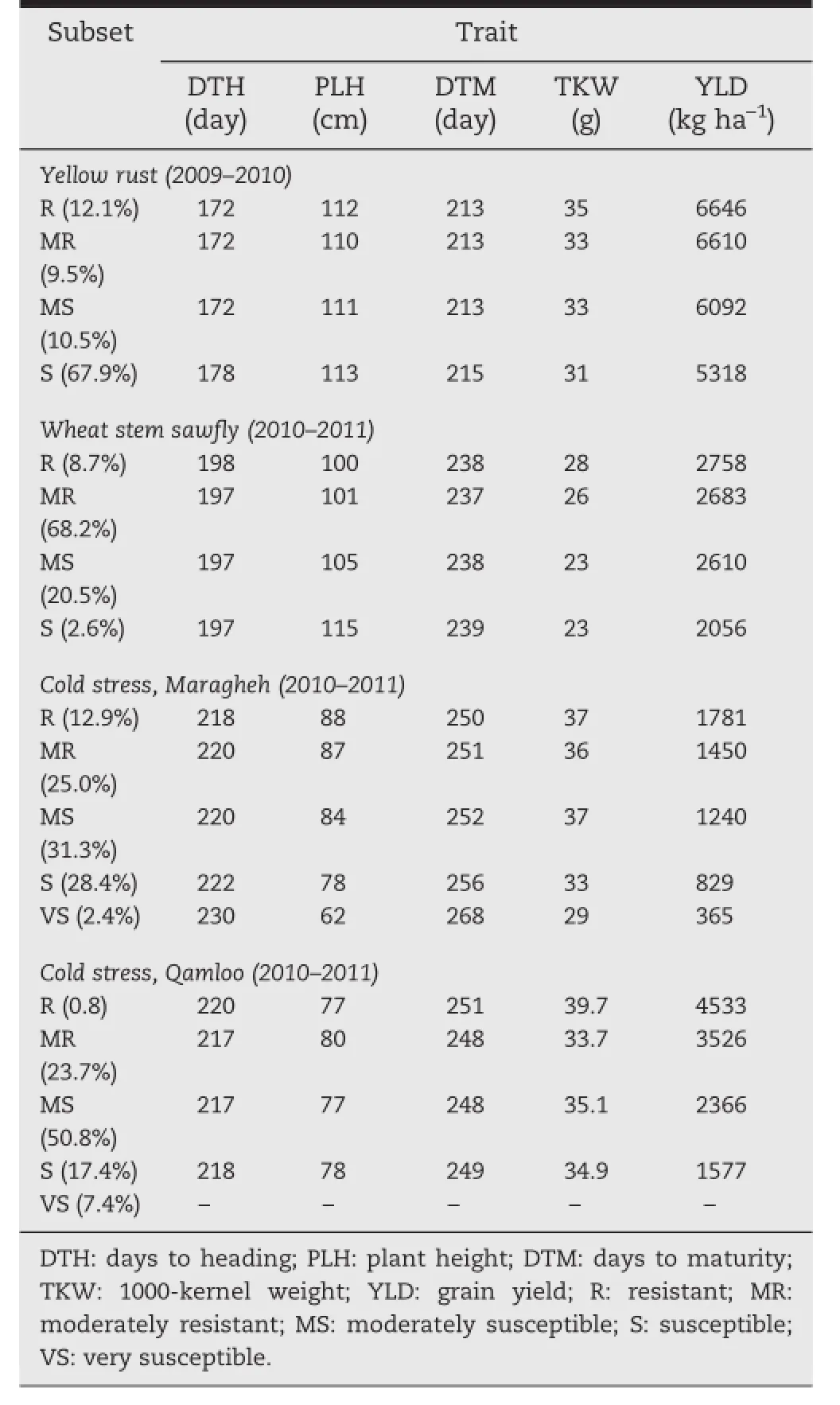
Table 3-Agronomic characteristics of different subsets of 380 durum wheat landraces in reaction to different environmental stresses.
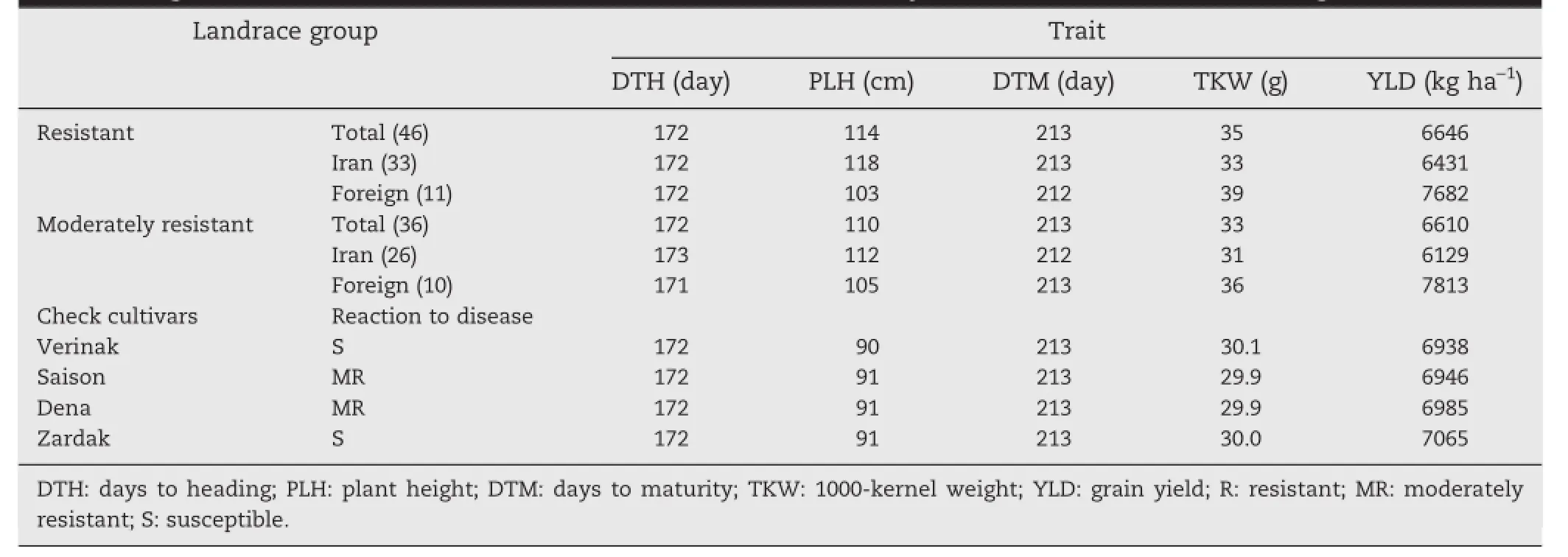
Table 4-Agronomic characteristics of landraces resistant or tolerant to yellow rust in relation to their origin.
3.4.3.Cold stress
Agronomic characteristics of the resistant and moderately resistant landraces to cold stress at Maragheh location are presented in Table 6.Compared to Iranian,the foreign resistant landraces produced higher yield and higher TKW,and were shorter in plant height and slightly earlier in heading and maturity.The foreign resistant landraces were from Japan,Afghanistan and Portugal,and those from Japan were amongst the highest yield and TKW with short stature. The Iranian landraces were the best in grain yield among the moderately resistant ones.Those with unknown origin had the lowest yields and were late in heading and maturity than others.Foreign landraces with moderate resistance to cold stress were from Argentina,Australia,Bulgaria,China,Iraq,Turkey and the U.S.The landraces from China and America produced the highest and the lowest yield among moderately resistant foreign landraces,respectively.The landraces from China and Australia had the highest(39 g)and the lowest (31 g)TKW,respectively.The shortest and the tallest landraces belonged to Iraq(81 cm)and China(95 cm),respectively. The landraces from Iraq tended to be early in heading,while those from Turkey were late in heading.The landraces from Bulgaria were early in maturity and those from Iraq tended to be late in maturity.
At Qamloo,only three landraces from Iran showed adequate resistance to cold stress.Compared to the foreign landraces,the Iranianonesproducedhigheryield,hadslightlyhigherTKW,and were taller and earlier in heading and maturity.One landrace of unknown origin produced higher grain yield and was taller than the Iranian ones(Table 7).The foreign landraces with moderate resistance to cold stress were from Afghanistan,Australia,Iraq,Italy,Japan,Turkey,the U.S.,and Yugoslavia.Those from Japan had the highest grain yield and TKW with early heading andmaturity,while those from Yugoslavia had the lowest yield and TKW with late heading and maturity dates.The landraces from Afghanistan were shortest and those from Iraq and Italy were tallest.

Table 5-Agronomic characteristics of landraces resistant/tolerant to wheat stem sawfly in relation to their origin.
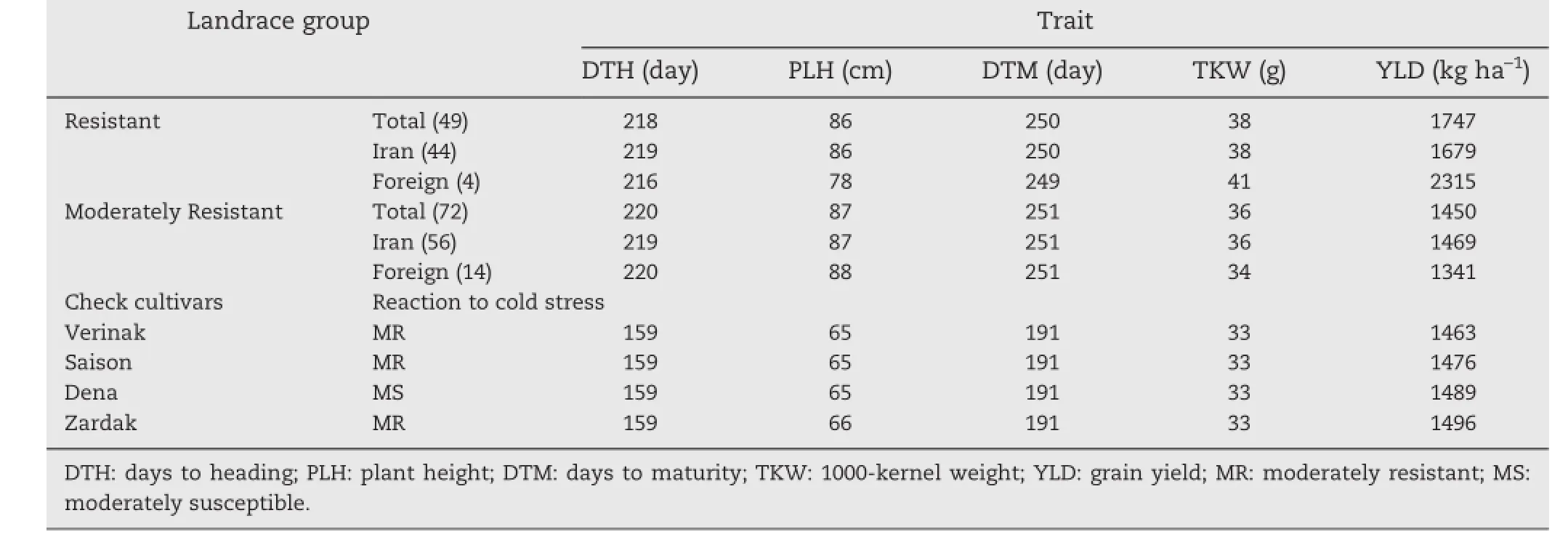
Table 6-Agronomic characteristics of cold stress resistant/tolerant landraces in relation to their origin at Maragheh location.
3.5.Visual characterization of landrace groups for environmental stresses
Fig.2 shows a polygon view of a GT biplot generated from data for five agronomic traits of different landrace groups for each environmental stresses.The GT biplots explained 94.0%to 98.9%ofthetotalvariation(Fig.2).Underyellowrustconditions,theresistant(R)grouphadthehighestvaluesforgrainyieldand TKW,whereas the susceptible(S)group was tallest in stature and tended to flower and mature later than the other groups. The MR and MS groups with no traits in their sectors were not the best for any of the traits.Under wheat stem sawfly(WSS)infestation(Fig.2),the R group had the highest values for TKW and yield and tended to be late in flowering.The S group,with high plant stature,tended to mature later than the other groups.
Under cold stress at Maragheh(Fig.2),the R and MR groups had the highest values for yield,TKW,and PLH,whereas the VS group,with the highest DTH and DTM,tended to flower and mature later than theother groups.Similarly,under severe cold stress at Qamloo(Fig.2),the R group had the highest yield and TKW and was later in flowering and maturity,while the MR group was the tallest among the landrace groups.
Underyellowrustinfestation(Fig.3),acloserelationshipwas found between phenological traits(DTH and DTM).These traits were positively associated with plant height and negatively associated with grain yield and TKW,indicating that selection for earliness directlyenhanced grainyield and productivity.The R group,with earlier flowering and maturity,had higher grain weightandproductivity,whiletheSgroupwaslaterinflowering and maturity and poor in yield productivity.
Under WSS%infestation(Fig.3),yield,TKW and DTH had positive correlations and were negatively associated with PLH and DTM.In comparison to the others,the R and MR groups had higher DTH and grain weight and tended to be earlier in maturity and shorter in stature.
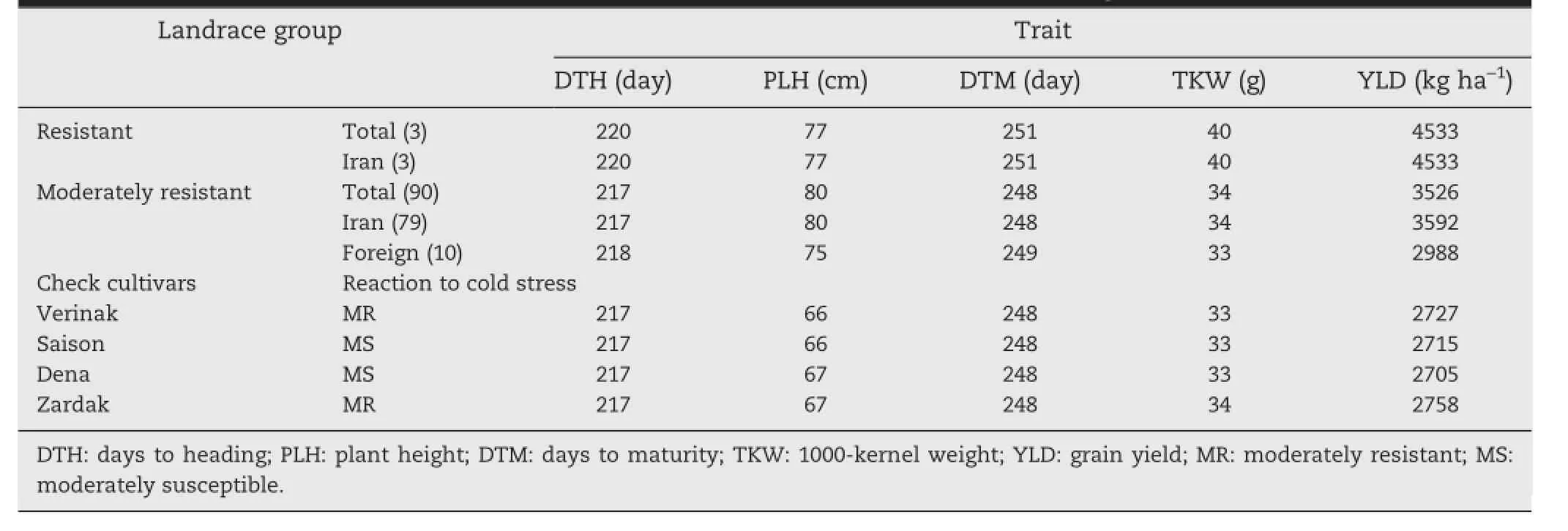
Table 7-Characteristics of cold stress resistant/tolerant landraces in relation to their origin at the Qamloo location.
Under cold stress at Maragheh(Fig.3),TKW and PLH were closely correlated with grain yield.These traits were negatively associated with phenological traits,as indicated by the obtuse angle between their vectors.In comparison to other groups,the R and MR groups had higher grain yield,and were earlier in flowering and maturity and tallest in stature,whereas the VS group tended to be later in flowering and shorter in stature.
Under severe cold stress at Qamloo(Fig.3),TKW,DTH,and DTM were closely correlated.These traits were positively associated with grain yield and negatively with plant height. The R group had higher grain weight and later flowering and maturity with high yield productivity,while the MR group was tallest in stature early in flowering and maturity,lower in grain weight,and relatively high in yield productivity.These results indicated that the grouping of traits under different environmentalstresseswas notconsistentandthattheperformanceof genotypes was influenced by environmental stresses.
Phenotypic correlations among agronomic traits across locations are presented in Table 8.Positive correlations were observed between days to heading and plant height(r=0.481,P<0.01),days to maturity(r=0.690,P<0.01)and 1000-kernel weight(r=0.352;P<0.01).Plant height was also significantly correlated with days to maturity(r=0.704;P<0.01)and 1000-kernel weight(r=0.365,P<0.01).The 1000-kernel weight had the highest correlation with days to maturity(r=0.544;P<0.01),while the highest correlation with grain yield was found for 1000-kernel weight(r=0.260;P<0.01)followed by days to maturity(r=0.201;P<0.01).No significant correlation with days to heading andplant heightwas foundfor grainyield.
4.Discussion
The climatic conditions that prevailed during the 2009—2011 cropping seasons showed that the planted landraces are subjected to varying degrees of cold stress combined with drought stress,yellow rust,and wheat stem sawfly stress at different rainfed locations.The phenotypic diversity encountered in durum landraces indicates that there is a large potential for the improvement of durum wheat in cold rainfed areas of Iran.This wide variation is probably only a proportion of the variation present in durum wheat worldwide[18—23],and further evaluation to use and conserve this potentially valuable genetic resource appears warranted.Breeding strategies need to exploit existing variation to broaden the genetic base of durum wheat landraces.Future mining of wheat collections for resistance or tolerance to biotic and abiotic stresses will be based on the choice of resistant and tolerant landraces using the focused identification of germplasm strategy(FIGS)[24].
The phenotypic diversity and variation in the durum landraces indicated high potential for durum breeding for agronomic traits and for common biotic and abiotic stresses under Mediterranean conditions,particularly in Iran.With respect to yield productivity under environmental stresses,we found many landraces with high grain yield in the three locations.Another example is plant height,where we found superior landraces under rainfed conditions in the three locations.This finding indicates the potential of genetic materials to produce tall cultivars,a trait important for adaptation in dry areas,given that one of the main effects of a dry spell during the growing season is a drastic reduction of stem elongation with a reduction in straw yield.This reduction also makes combine harvesting difficult or impossible.Our study showed the potential of some landraces to produce tall plants under drought and cold conditions,and such landraces will be useful for improving plant height in cultivated durum.However,our results showed that tall landraces were susceptible to wheat stem sawfly,which causes reduction in yield and TKW.Based on the results,for environments under biotic stresses such as wheat stem sawfly the cultivation of taller plants should not be practiced. Gregoire[25]reported that most cultivars are susceptible,whereas other sources indicated that much variation exists for wheat stem sawfly susceptibility in durum [26,27].Our results,in which the landraces differed for infestation by WSS and few sources of resistance to WSS were found,are in agreement with these findings.
Similarly,reductions in grain yield and TKW from subsets of resistant to susceptible landraces to yellow rust diseasewere observed,indicating that grain yield and TKW are substantially influenced by yellow rust.This result is in agreement with those of other reports[28,29]that yield losses from leaf rust are due mostly to reduction in kernel weight.
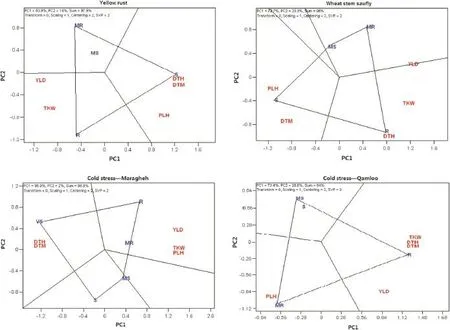
Fig.2-“Which-win-where”patterns of genotype-by-trait(GT)biplots of landrace groups for five traits under different environmental stresses.DTH:days to heading;DTM:days to maturity;PLH:plant height;TKW:1000-kernel weight;YLD:grain yield.R:resistant;MR:moderately resistant;MS:moderately susceptible;S:susceptible;VS:very susceptible.
Climate and soil in the regions in which genotypes originate can influence their characteristics,especially in landraces,where environmental conditions can have substantial influence.High frequencies of landraces with early heading and early maturity in semiarid regions are considered [30]as indicators of increased tolerance to drought.Some landraces with earlier heading and maturity under rainfed conditions and with high levels of tolerance to biotic and abiotic stresses were found.This is another example of the potential of durum landraces to improve the adaptation of cultivated durum to drought-prone areas.Earliness is an important adaptive attribute as a drought escape mechanism under terminal drought conditions,and as a result,early lines will produce higher yields than late genotypes,particularly in very dry years[31].Based on the above evidence,several landraces used in this study showed high levels of variation and desirable expression of tolerance or resistance to environmental stresses and the other important traits.Landraces with outstanding drought tolerance will be used as source of new diversity to develop new cultivars.
Cold tolerance is a desirable plant characteristic for autumn-sown cereals in continental and mountainous areas oftheMediterraneanregions,whicharecharacterizedbywinter andunpredictablelatefrostsinspring.However,landracesarea source of cold tolerance in cereal breeding,given that some possess high genetic variation for this character[32].The evaluation of 380 landraces selected from the world collection conserved in Iran's gene bank indicated few sources of cold resistance when tested under cold-stressed locations,where only 0.8—12.7%of landraces were found to be resistant.Thus,to expand the cultivation of durum wheat to the highlands of Iran and other cold winter areas,special efforts are needed to develop durum wheat varieties with high cold tolerance and winter hardiness.Thiseffortwillneedtousethelandracesandavailable parentalbreedinglandracesdevelopedforcoldareas.Inaddition,introgression of cold-tolerance and winter-hardiness genes (traits)from wild Triticum and Aegilops species that exhibit winter growth habit and cold tolerance can be performed. Further collection to target underrepresented agro-ecological zones such as Asian and European zones is generally suggested for maximum diversity sampling.New collecting missions targeting cold-tolerant landraces are needed to enrich gene bank holdings with durum wheat landraces and with primitive wheat and wild relatives with sufficient cold tolerance to survive under severe cold and drought stresses.
Landraces resistant to environmental stresses were found among both Iranian and foreign landraces.Iranian and foreignresistantlandracesdifferedintheiragronomicperformance depending on the kinds of stress.For example,under epidemic yellow rust infection,the foreign resistant landraces were characterized by higher yield productivity and TKW than the Iranian landraces.In contrast,under infestation by WSS,the Iranian resistant landraces were characterized by high yield,TKW,plant stature,and earliness in heading and maturity.Under cold stress,the Iranian resistant landraces had higher yield and TKW.
Resistance to environmental stresses and high yield are the key requirements for evaluating the success of durum wheat as an important cereal crop in highland rainfed areas of Iran.Landraces with high genetic diversity should be selected and crossed with locally adapted landraces and varieties to achieve breakthroughs in durum wheat genetic improvement. For higher yield under yellow rust epidemics,foreign landraces,particularly those from Japan,should be used,while under infestation by WSS the Iranian landraces and under cold stress the foreign landraces from Japan,Afghanistan,and Portugalshouldbegivenpriority.Selectionbasedon flowering,maturity,grain weight,and plant height,exploiting the variation among landraces,may enhance the genetic yield potential in cold and moderately cold rainfed areas of Iran.In conclusion,our results suggest that the early maturing,high yielding,and resistant durum wheat landraces held in the Iranian gene bank can adapt to the stressful environments of Iran and elsewhere and can be used for durum breeding targeting the development of improved varieties for cold and drought-prone environments.

Fig.3-Genotype-by-trait(GT)biplot showing relationships among traits under different environmental stresses.DTH:days to heading;DTM:days to maturity;PLH:plant height;TKW:1000-kernel weight;YLD:grain yield.R:resistant;MR:moderately resistant;MS:moderately susceptible;S:susceptible;VS:very susceptible.
Acknowledgment
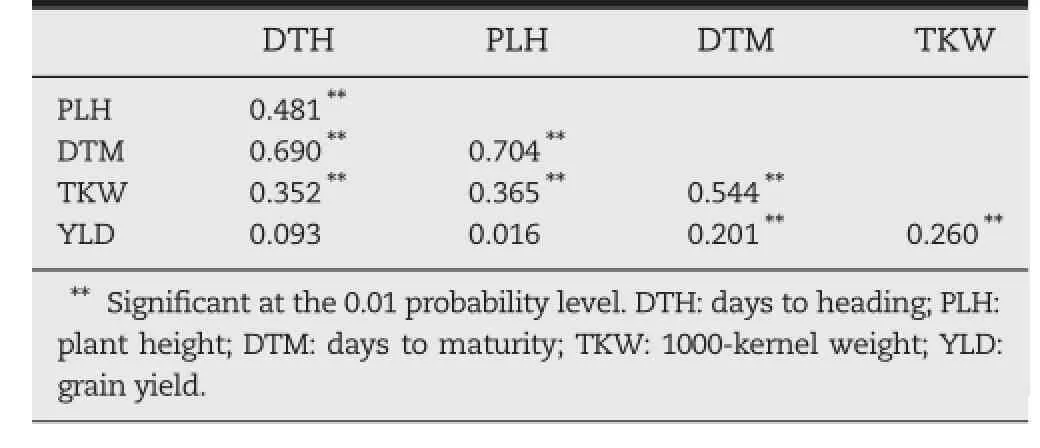
Table 8-Phenotypic correlations among agronomic traits across locations(n=384).
This research was a part of the regional durum wheat research project of the Dryland Agricultural Research Institute(DARI)of Iran and was supported by the Agricultural Research and EducationOrganization(AREEO).Theauthorsthanktwoanonymous reviewers for their comments,discussions,and corrections on the manuscript.The authors also acknowledge the assistance of Professor James Nelson(Kansas State University)for valuable editorial and English improvements.
R E F E R E N C E S
[1]A.A.Jaradat,Wheat Landraces:Genetic Resources for Sustenance and Sustainability,USDA-ARS,Morris,USA,2012.
[2]P.W.Heisey,M.A.Lantican,H.J.Dubin,Impacts of International Wheat Breeding Research in Developing Countries 1966—1997,CIMMYT,Mexico,D.F.,Mexico,2002.
[3]R.P.Ellis,B.P.Foster,D.Robinson,L.L.Handley,D.C.Gordon,J.R.Russell,W.Powell,Wild barley:a source of genes for crop improvement in the 21st century?J.Exp.Bot.51(2000)9—17.
[4]N.Z.Ergen,H.Budak,Sequencing over 13000 expressed sequence tags from six subtractive cDNA libraries of wild and modern wheats following slow drought stress,Plant Cell Environ.32(2009)220—236.
[5]D.Fleury,S.Jefferies,H.Kuchel,P.Langridge,Genetic and genomic tools to improve drought tolerance in wheat,J.Exp. Bot.61(2010)3211—3222.
[6]Z.Xin,J.Browse,Cold comfort farm:the acclimation of plants to freezing temperatures,Plant Cell Environ.23(2001)893—902.
[7]G.S.Sanghera,S.H.Wani,W.Hussain,N.B.Singh,Engineering cold stress tolerance in crop plants,Curr.Genomics 12(2011)30—43.
[8]D.J.Samborski,Wheat leaf rust,in:A.P.Roelfs,W.R. Bushnell(Eds.),The cereal rusts.Vol.II.Diseases,distribution,epidemiology,and control,Academic Press,Orlando 1985,pp.39—59.
[9]J.M.Prescott,P.A.Burnett,E.E.Saari,J.Ranson,J.Bowman,W. de Milliano,R.P.Singh,G.Bekele,Wheat disease and pests:a guide for field identification,CIMMYT,Mexico,D.F.,Mexico,1986.
[10]N.N.Sãulescu,H.J.Braun,Breeding for adaptation to environmental factors,Cold tolerance,in:M.P.Reynolds,J.I. Ortiz-Monasterio,A.McNab(Eds.),Application of Physiology in Wheat Breeding,CIMMYT,Mexico,D.F.,Mexico 2001,pp.111—123.
[11]S.Ceccarelli,S.Grando,M.Baum,S.Udupa,Breeding for drought resistance in a hanging climate,in:C.A.Roberts(Ed.)Challenges and Strategies for Dryland Agriculture Crop Science Society of America Inc and American Society of Agronomy Inc,Madison,Wisconsin,USA 2004,pp.167—190.
[12]R.P.Singh,H.W.William,J.Huerta-Espino,G.Rosewarne,Wheat rust in Asia:meeting the challenges with old and new technologies,Proceedings of the 4th International Crop Science Congress,Sep.26—Oct.1,2004,Brisbane,Australia,2004.
[13]R.F.Peterson,A.B.Campbell,A.E.Hannah,A diagrammatic scale for estimating rust severity on leaves and stems of cereals,Can.J.Res.Sect.C,Bot.Sci.26(1948)496—500.
[14]R.W.Payne,D.A.Murray,S.A.Harding,D.B.Baird,D.M. Soutar,GenStat for Windows 12th Edition,Introduction,VSN International,Hemel Hempstead,UK,2009.
[15]M.Singh,R.S.Malhotra,S.Ceccarelli,A.Sarker,S.Grando,W. Erskine,Spatial variability models to improve dryland field trials,Exp.Agric.39(2003)1—10.
[16]W.Yan,I.Rajcan,Biplot evaluation of test sites and trait relations of soybean in Ontario,Crop Sci.42(2002)11—20.
[17]W.Yan,GGE biplot—a Windows application for graphical analysis of multi-environment trial data and other types of two-way data,Agron.J.93(2001)1111—1118.
[18]A.Elings,Durum wheat landraces from Syria:II.Patterns of variation,Euphytica 54(1991)231—243.
[19]A.A.Jaradat,Breeding potential of durum wheat landraces from Jordan I.Phenotypic diversity,Hereditas 116(1992)301—304.
[20]L.Pecetti,G.Boggini,J.Gorham,Performance of durum wheat landraces in a Mediterranean environment(eastern Sicily),Euphytica 80(1994)191—199.
[21]P.Gavuzzi,G.Delogu,G.Boggini,N.Di Fonzo,B.Borghi,Identification of bread wheat,durum wheat and barley cultivars adapted to dry areas of Southern Italy,Euphytica 68 (1993)131—145.
[22]M.A.Pagnotta,A.Impiglia,O.A.Tanzarella,M.M.Nachit,E. Porceddu,Genetic variation of the durum wheat landrace Haurani from different agro-ecological regions,Genet. Resour.Crop.Evol.51(2004)863—869.
[23]M.Moragues,L.F.Garcıa del Moral,M.Moralejo,C.Royo,Yield formation strategies of durum wheat landraces with distinct pattern of dispersal within the Mediterranean basin:I.Yield components,Field Crop Res.95(2006)194—205.
[24]A.Bari,K.Street,M.Mackay,D.T.F.Endresen,E.De Pauw,A. Amri,Focused Identification of Germplasm Strategy(FIGS)detects wheat stem rust resistance linked to environmental variables,Genet.Resour.Crop.Evol.59(2012)1465—1481.
[25]T.Gregoire,Wheat stem sawfly variety tolerance,North Dakota State University,2005.(http://www.ag.ndsu.nodak. edu/aginfo/procrop/hrs/whstva08/html).
[26]J.Jones,Wheat stem sawfly.Agri-Facts,Alberta Agric.Food Rural Dev.Agdex(1995)622—626.
[27]H.B.Goosey,A.W.Lenssen,G.D.Johnson,S.L.Blodgett,G.R. Carlson,K.D.Kephart,Durum spring wheat susceptibility to wheat stem sawfly(Hymenoptera:Cephidae),J.Entomol.Sci. 42(2007)133—138.
[28]Y.Andenow,M.Hullukal,G.Belay,T.Tesemma,Resistance and tolerance to leaf rust in Ethiopian tetraploid wheat landraces,Plant Breed.116(1997)533—536.
[29]J.Huerta-Espino,R.P.Singh,S.German,B.D.McCallum,R.F. Park,W.Chen,S.C.Bhardwaj,H.Goyeau,Global status of wheat leaf rust caused by Puccinia triticina,BGRI Technical Workshop,May 30—31,2010,St Pertersburg,Russia,2010.
[30]A.Blum,G.Golan,J.Mayer,B.Sinmena,L.Shpiler,J.Burra,The drought response of landraces of wheat from the northern Negev desert in Israel,Euphytica 43(1989)87—96.
[31]M.Rousset,I.Bonnin,C.Remoué,M.Falque,B.Rhoné,J.B. Veyrieras,D.Madur,A.Murigneux,F.Balfourier,J.Le Gouis,S. Santoni,I.Goldringer,Deciphering the genetics of flowering time by an association study on candidate genes in bread wheat(Triticum aestivum L.),Theor.Appl.Genet.123(2011)907—926.
[32]A.Elings,M.M.Nachit,Field evaluation and simulation of frost tolerance in Syrian durum wheat landraces,Neth,J.Life Sci.41(1993)1—11.
*Corresponding author.
E-mail address:r.mohammadi@areo.ir(R.Mohammadi).
Peer review under responsibility of Crop Science Society of China and Institute of Crop Science,CAAS.
http://dx.doi.org/10.1016/j.cj.2015.03.008
2214-5141/©2015 Crop Science Society of China and Institute of Crop Science,CAAS.Production and hosting by Elsevier B.V.This is an open access article under the CC BY-NC-ND license(http://creativecommons.org/licenses/by-nc-nd/4.0/).
12 December 2014
杂志排行
The Crop Journal的其它文章
- Tillage and straw mulching impacts on grain yield and water use efficiency of spring maize in Northern Huang-Huai-Hai Valley
- Genetic diversity and association mapping for salinity tolerance in Bangladeshi rice landraces
- Physiological responses of Brassica napus to fulvic acid under water stress:Chlorophyll a fluorescence and antioxidant enzyme activity
- Genetic diversity and DNA fingerprinting in jute (Corchorus spp.)based on SSR markers
- Genomewide association study of Aegilops tauschii traits under seedling-stage cadmium stress
- Crop rotation-dependent yield responses to fertilization in winter oilseed rape(Brassica napus L.)
